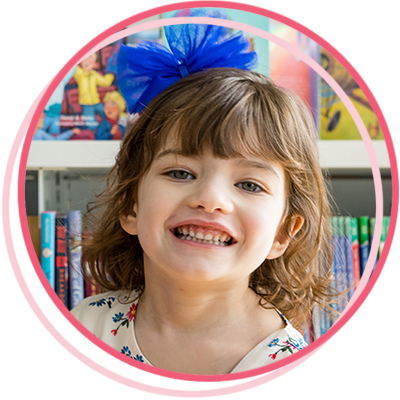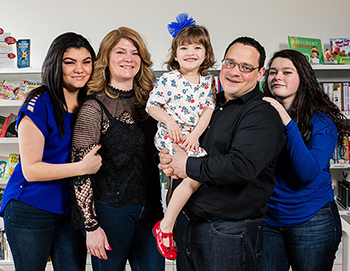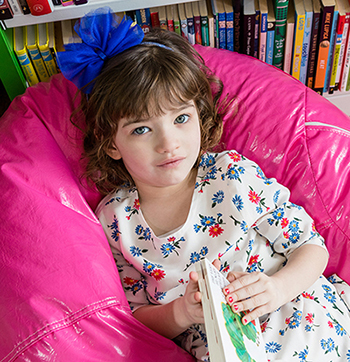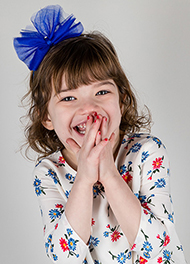Gabriella Trobia
Newborn Struggles to Breathe from Rare Condition, Beats the Odds after 47 days in the NICU
 Alexandria and Emily Trobia could see the doors to the delivery room at Highland Hospital as they eagerly awaited the arrival of their baby sister, Gabriella. But what began as a quick and normal delivery would soon turn into an unexpected and dreadful waiting period for the family. Something must have gone wrong, but with whom? Was it their mom? Was it their baby sister? As they waited for answers, their mother, Kim, was overcome with fear in the delivery room as she realized her youngest daughter wouldn’t be heading home any time soon. In fact, Kim didn’t know if Gabriella would survive the grave complications that arose after her birth.
Alexandria and Emily Trobia could see the doors to the delivery room at Highland Hospital as they eagerly awaited the arrival of their baby sister, Gabriella. But what began as a quick and normal delivery would soon turn into an unexpected and dreadful waiting period for the family. Something must have gone wrong, but with whom? Was it their mom? Was it their baby sister? As they waited for answers, their mother, Kim, was overcome with fear in the delivery room as she realized her youngest daughter wouldn’t be heading home any time soon. In fact, Kim didn’t know if Gabriella would survive the grave complications that arose after her birth.
When doctors cut the umbilical cord, Gabriella was unable to breathe on her own and her heart rate began to drop. Four years later, Kim still remembers overhearing the phone call staff made to the Golisano Children’s Hospital (GCH) transport team, asking for immediate help.
“I heard them say ‘Get the crash cart ready.’ I had no idea if she was going to make it,” said Kim.
The neonatal medical transport team arrived within minutes after delivery and worked with the Highland medical team to continue the resuscitation and CPR on Gabriella. It took two hours to stabilize the newborn before she was able to be transported to GCH for continued care. Kim will never forget the comfort she received from her obstetrician, Rita Clement, M.D., who stayed with her for more than two hours after delivering Gabriella.
“That was an experience that is difficult to put into words. Kim and her family showed incredible strength during an extremely difficult time,” said Clement. Kim was transferred shortly after, where Kim would find herself by Gabriella’s side in the NICU for the next 47 days.

Gabby with her parents Kim and Steve, and siblings Alexandria and Emily.
Trying to Understand
Upon arrival to GCH, Gabriella required significant breathing support from a ventilator and was still very unstable. After several chest X-rays, the medical team determined that the space around Gabriella’s lungs was filled with fluid and an emergent procedure was needed to help drain the fluid so she could get the vital oxygen she needed.
“Gabriella was diagnosed with a rare neonatal condition called congenital chylothorax,” according to Christina Sollinger, M.D., a neonatologist at GCH who was involved in Gabriella’s care.
“Lymphatic fluid circulates throughout the body; however, in newborns with this diagnosis, the circulation of that fluid is abnormal and fluid can build up in spaces around the lungs. This makes it very difficult for these infants to open their lungs and breathe,” said Sollinger.
Additionally, because of the challenges that Gabriella had getting oxygen after birth, there was significant concern about potential brain injury. Gabriella was also diagnosed with hypoxic ischemic encephalopathy (HIE) and was placed on a cooling blanket for 72 hours to help her brain recover.
When Kim learned that her newborn had not only one, but two potentially life-threatening diagnoses, she blamed herself: “What did I do? How did I cause this?” Kim didn’t experience any medical issues with her two older daughters, so she had a hard time making sense of Gabriella’s diagnosis and how it happened. The medical team reassured Kim that she was not to blame.
What Happens Next
 Congenital chylothorax is a rare and complicated condition that affects approximately 1 in 10,000 newborns with a mortality rate that ranges between 20 to 60 percent. With the additional diagnosis of HIE, Gabriella’s prognosis was uncertain. “This was a challenging situation because we were dealing with two serious medical conditions that required hour-by-hour assessment and treatments. The first few days were tenuous for Gabriella,” said Sollinger.
Congenital chylothorax is a rare and complicated condition that affects approximately 1 in 10,000 newborns with a mortality rate that ranges between 20 to 60 percent. With the additional diagnosis of HIE, Gabriella’s prognosis was uncertain. “This was a challenging situation because we were dealing with two serious medical conditions that required hour-by-hour assessment and treatments. The first few days were tenuous for Gabriella,” said Sollinger.
Kim remained by Gabriella’s side day in and day out as the newborn remained under sedation. “She seemed to be getting better, but every time she had a setback, it was a really big setback and I wondered if she was going to survive,” said Kim.
The medical team was cautiously optimistic. With two serious diagnoses and multiple tubes running through Gabriella, Kim says there were many highs and lows. The mom of three recalls doctors sharing several concerns with her. “They weren’t really sure what her level of function would be if she survived. They were also preparing for Gabriella to experience seizures once she came out of sedation. All we could do was wait and see.”
After Gabriella was taken off the cooling blanket, she started to quickly show promising signs of brain recovery. “She opened her eyes, would look right at us, responded to touch, and although still dependent on a breathing tube and ventilator, was trying to breathe on her own. We were very hopeful for a full neurological recovery for Gabriella,” shared Sollinger. After weeks of medical treatment, and with the support of a ventilator, the fluid accumulation in Gabriella’s chest for the congenital chylothorax slowed down. Her chest tubes were removed and, eventually, Gabriella no longer needed the ventilator to breathe.
Going Home
While overjoyed, Kim was also nervous when Gabriella was cleared to go home. “She had so many breathing issues … I was afraid I wouldn’t know what to do if she went into distress,” said Kim. She also had to reduce Gabriella’s fat intake by skimming her breast milk and combining it with a special formula available only at Strong. “She was on eight different medications. It was a lot to handle, especially because she also had pulmonary, cardiology, and gastroenterology appointments she had to go to,” said Kim.
 Kim credits the medical staff for giving her the strength to get through such a grim experience. “They were the most amazing doctors and nurses in my life.” What the doctors and nurses may have not realized during Gabriella’s care is how Kim was watching them, for reassurance. “They may have been nervous, but they always remained calm. It was amazing.”
Kim credits the medical staff for giving her the strength to get through such a grim experience. “They were the most amazing doctors and nurses in my life.” What the doctors and nurses may have not realized during Gabriella’s care is how Kim was watching them, for reassurance. “They may have been nervous, but they always remained calm. It was amazing.”
Today, Gabriella is a happy and energetic 4-year-old. While there are some issues she still has to deal with, such as chronic lung disease and having to use a nebulizer for the common cold, which changes medication from a liquid to a mist so it can be more easily inhaled into the lungs, Gabriella is full of life and scores above average in everything she does.
“It’s hard to look at Gabriella today and imagine how incredibly sick she was when our neonatal transport team met her at Highland Hospital that night four years ago,” said Sollinger. “Her story is an excellent example of how multiple hospitals and medical teams work together to provide the best possible care for newborns in our community. Gabriella also had an incredible family who sat by her side every single day and participated in her daily care — something I am certain helped her recovery.”
Make a Gift to Golisano Children's Hospital